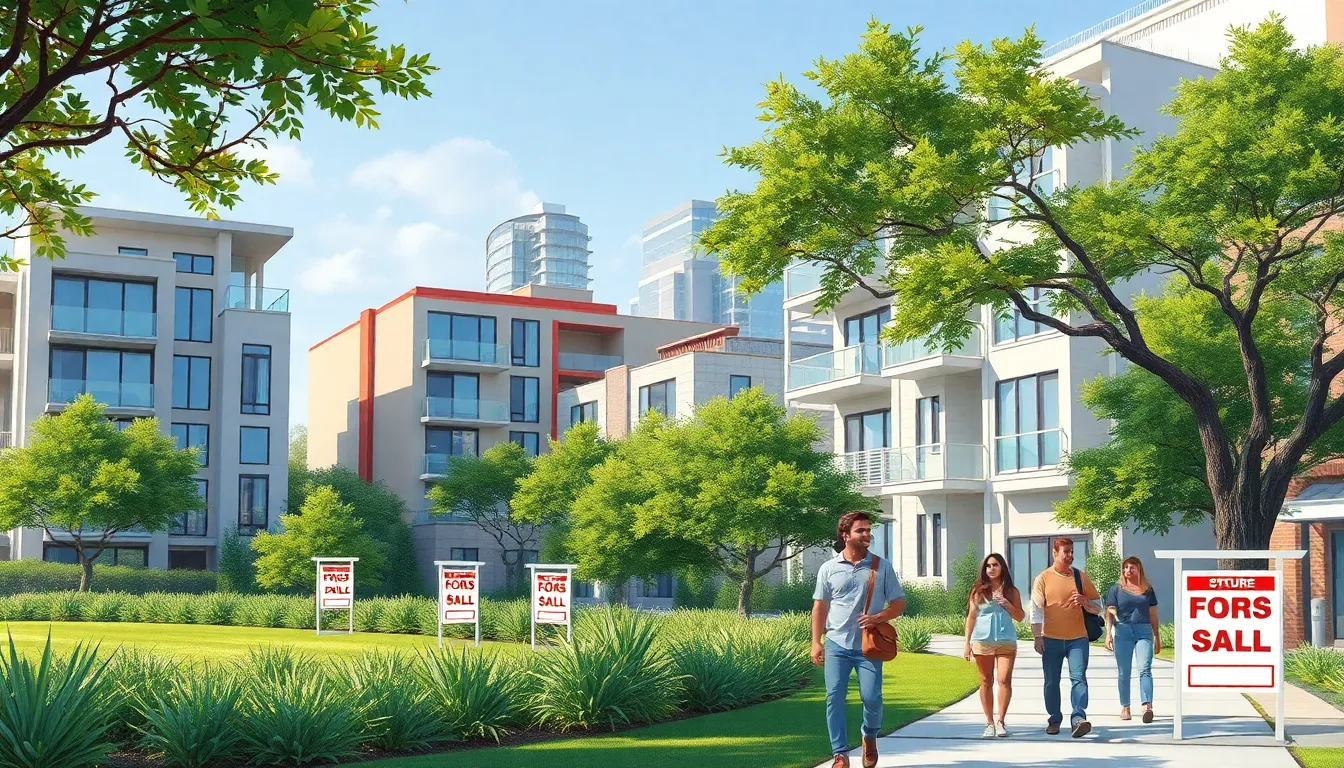Austin’s real estate market is hotter than a jalapeño in July, and for good reason. With its vibrant culture, booming tech scene, and mouthwatering barbecue, it’s no wonder people are flocking to the capital of Texas. Whether you’re a seasoned investor or a first-time homebuyer, staying ahead of the trends can make all the difference in navigating this competitive landscape.
From skyrocketing home prices to the rise of suburban living, understanding the latest shifts in Austin’s real estate market is crucial. It’s not just about finding a place to live; it’s about making a savvy investment in a city that’s constantly evolving. Buckle up as we dive into the trends shaping Austin’s real estate scene, because in this market, knowledge isn’t just power—it’s your ticket to success.
Table of Contents
ToggleOverview of Austin Real Estate Trends
Austin’s real estate market shows a dynamic evolution, reflecting the city’s growth and allure. Property values surged, with an average increase of 8% from 2022 to 2023. The median home price reached $610,000 in 2023, attracting both families and investors alike. Due to the thriving tech industry, demand for homes consistently rises, especially in tech-centric neighborhoods like East Austin and the Domain.
Inventory levels remain low, leading to a competitive market where buyers outnumber available properties. New construction continues to ramp up, with a focus on sustainable and eco-friendly homes, catering to the preferences of environmentally conscious buyers. Condos and townhomes gained popularity, representing a viable option for first-time homebuyers and millennials seeking urban living.
Interest rates experienced fluctuations, impacting buyer behavior. As rates increase, homebuyers tend to move quickly to secure properties before prices escalate further. Rent prices also climbed, averaging $2,400 per month for a two-bedroom apartment, emphasizing the rental market’s strength and the city’s appeal.
Homeowners are increasingly investing in renovations, enhancing property values and aesthetics. Popular upgrades focus on energy efficiency and open-concept designs, aligning with current buyer preferences. As the city evolves, neighborhoods like Pflugerville and Round Rock are emerging, offering affordable alternatives while maintaining proximity to downtown Austin.
Overall, understanding these trends equips buyers and investors with essential insight, ultimately aiding in decision-making within this vibrant market.
Current Market Landscape

Austin’s real estate market continues to evolve rapidly, with significant implications for buyers and investors.
Home Prices and Sales
Current statistics show an average property value increase of 8% from 2022 to 2023. Median home prices now sit at $610,000, reflecting heightened competition. Sales activity remains robust, driven by a strong demand for homes in popular areas. Buyers often encounter multiple offers on desirable properties, necessitating swift decision-making. First-time homebuyers increasingly turn to condos and townhomes, attracted by urban living options. Expanding neighborhoods like Pflugerville and Round Rock provide affordable choices for those looking to remain close to downtown.
Demand and Supply Factors
The thriving tech industry fuels the heightened demand throughout the city. Low inventory levels exacerbate the situation, with fewer homes available for sale. Builders focus on new constructions, particularly sustainable homes, to meet this demand. Many buyers aim to secure properties quickly, given fluctuating interest rates. Rent prices for two-bedroom apartments average $2,400 per month, further pushing potential buyers toward homeownership. Emerging tech-centric neighborhoods like East Austin and the Domain remain highly sought after, reflecting the market’s preference for areas that support a tech lifestyle.
Neighborhood Spotlights
Austin’s neighborhoods showcase diverse options for homebuyers, each offering unique amenities and lifestyle choices.
Popular Areas for Buyers
East Austin captures attention with its vibrant art scene and proximity to downtown. The Domain features luxury living and upscale shopping, attracting professionals. South Congress is known for its trendy eateries and music venues, appealing to a younger demographic. All these areas see strong demand, with buyers frequently facing multiple offers. Median home prices in these popular neighborhoods often exceed the citywide average, driving competition further. Current trends indicate that community engagement and local culture significantly enhance each neighborhood’s appeal.
Emerging Neighborhoods
Pflugerville stands out as an affordable option while maintaining excellent access to downtown Austin. Round Rock presents family-friendly environments coupled with strong schools, making it a favored choice for those with children. Both neighborhoods showcase new developments and increasing property values. Market data reveals that home prices in Pflugerville and Round Rock rise steadily, attracting both first-time buyers and investors. Connectivity via public transport and highways enhances their desirability. As urban sprawl continues, these emerging neighborhoods will likely benefit from ongoing investments and community growth.
Future Predictions
The Austin real estate market is expected to undergo further shifts. Future trends indicate steady growth fueled by ongoing demand and population influx.
Market Forecasts
Experts predict property values in Austin may rise by another 5% to 7% in 2024, driven by continued interest from tech companies and new inhabitants. Demand for homes in established neighborhoods like East Austin and the Domain will likely remain high due to their amenities and lifestyle. Emerging areas such as Pflugerville and Round Rock may see increased prices as more buyers seek affordable options near the city. Market analysts anticipate new developments focused on eco-friendly designs, catering to environmentally conscious consumers. Investor activity is also likely to stay robust, particularly in rental properties, as many shift from buying to leasing amid high prices.
Potential Challenges
Competition for available properties in Austin presents significant challenges. Buyers often face bidding wars, driving up prices beyond appraisal values. Additionally, fluctuating interest rates could deter some potential homeowners, complicating purchase decisions. New construction may temporarily alleviate inventory shortages, yet supply chain disruptions could delay projects. Rising building costs impact overall affordability for both new construction and existing homes, making market access more difficult for first-time buyers. Regulatory changes in zoning laws could further limit housing options, necessitating continued monitoring of legislative trends.
Austin’s real estate market continues to thrive amid evolving trends and increasing demand. As property values rise and competition intensifies, buyers must stay informed to navigate this dynamic landscape successfully. The city’s unique neighborhoods offer diverse options for both homeowners and investors, making it crucial to understand local market nuances.
With the ongoing influx of residents and a booming tech industry, the future of Austin real estate looks promising. However, challenges such as fluctuating interest rates and low inventory levels may complicate the buying process. By keeping a pulse on these trends, individuals can position themselves to make informed decisions and capitalize on opportunities in this vibrant market.







